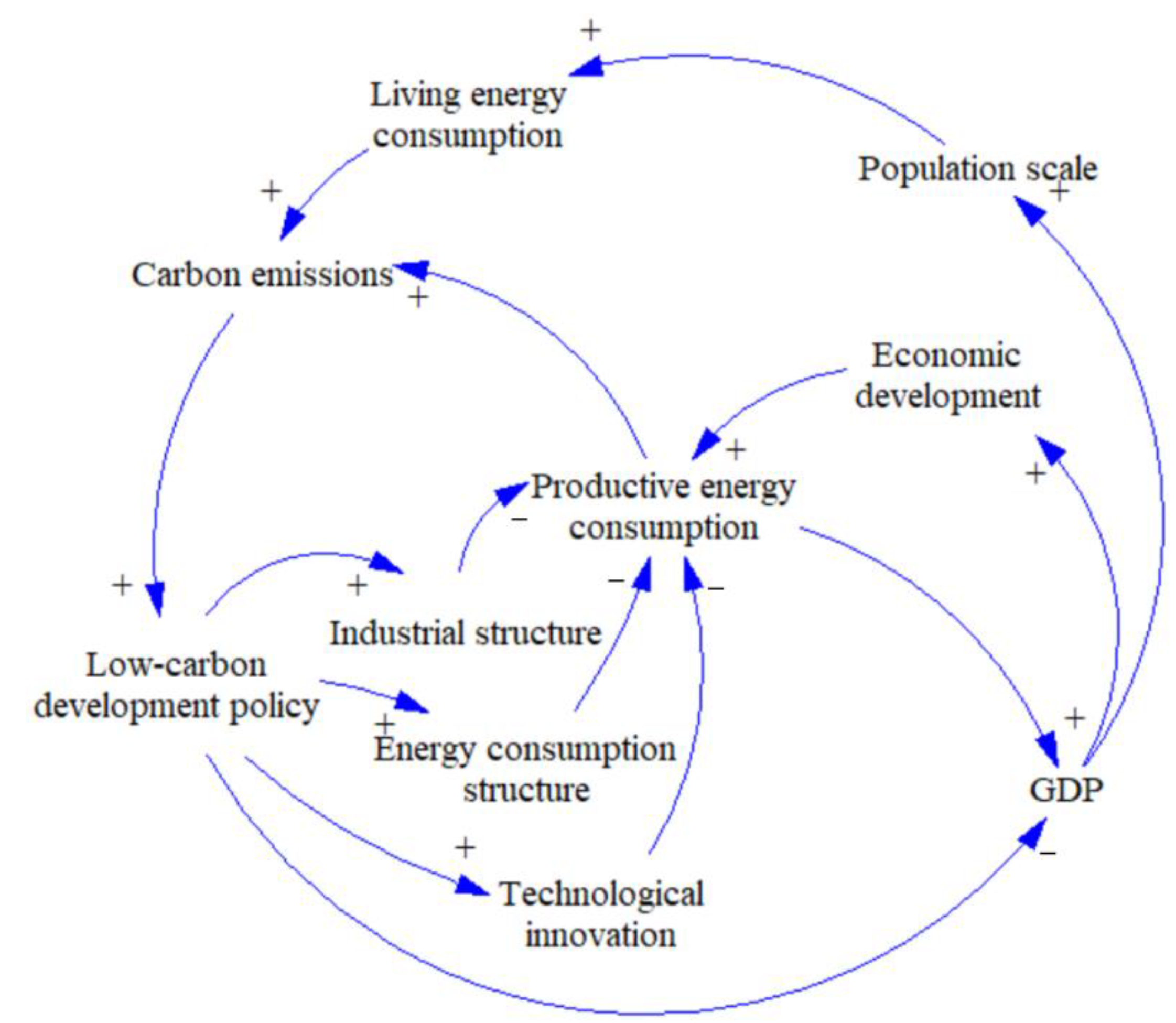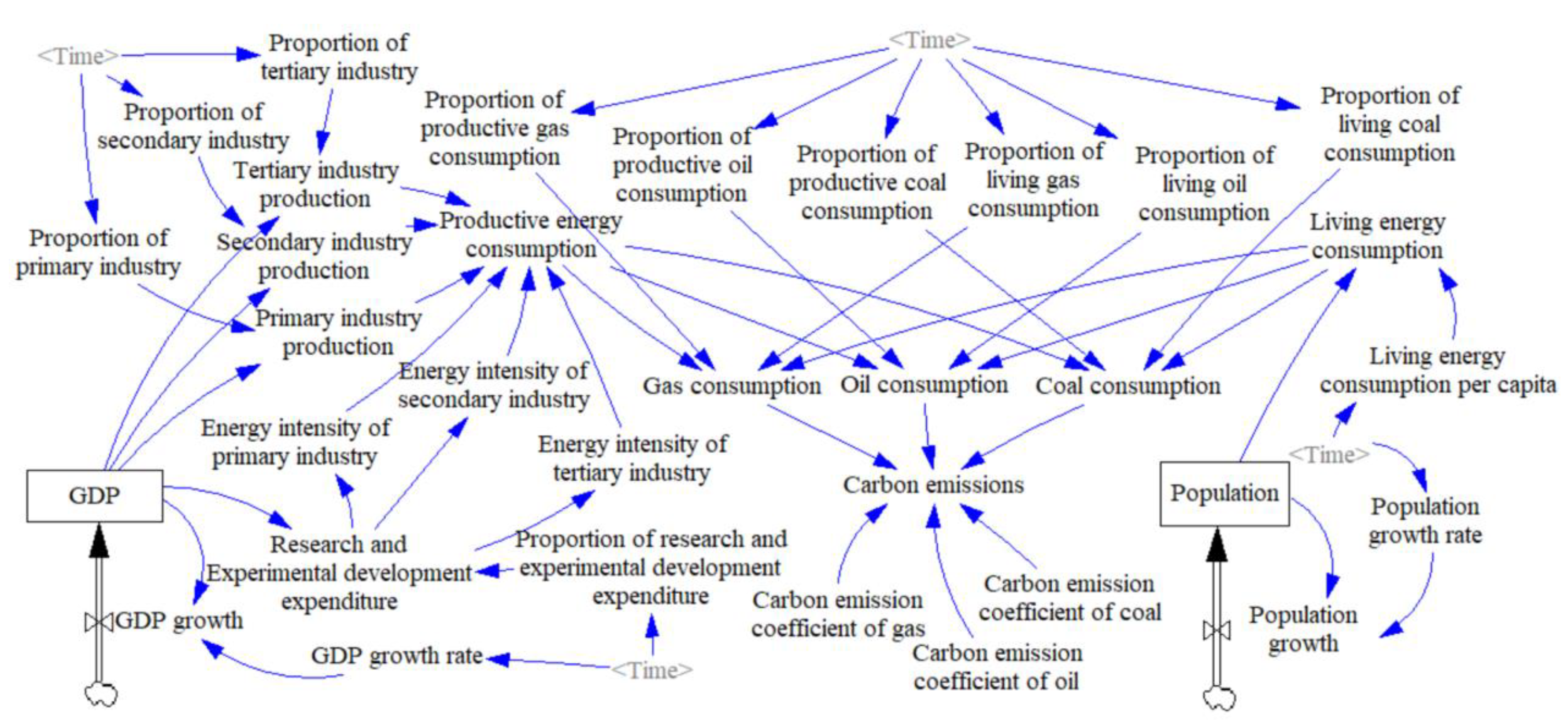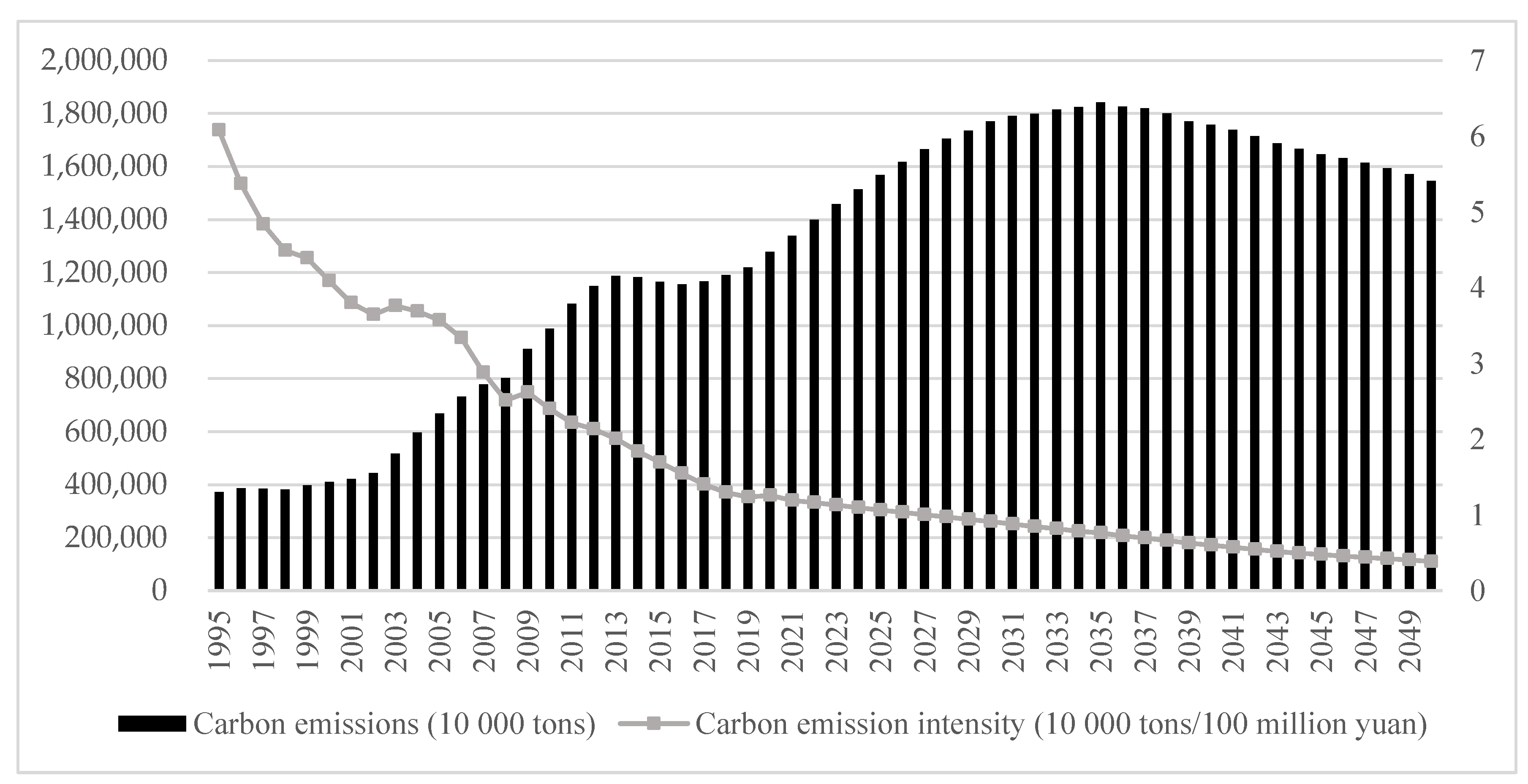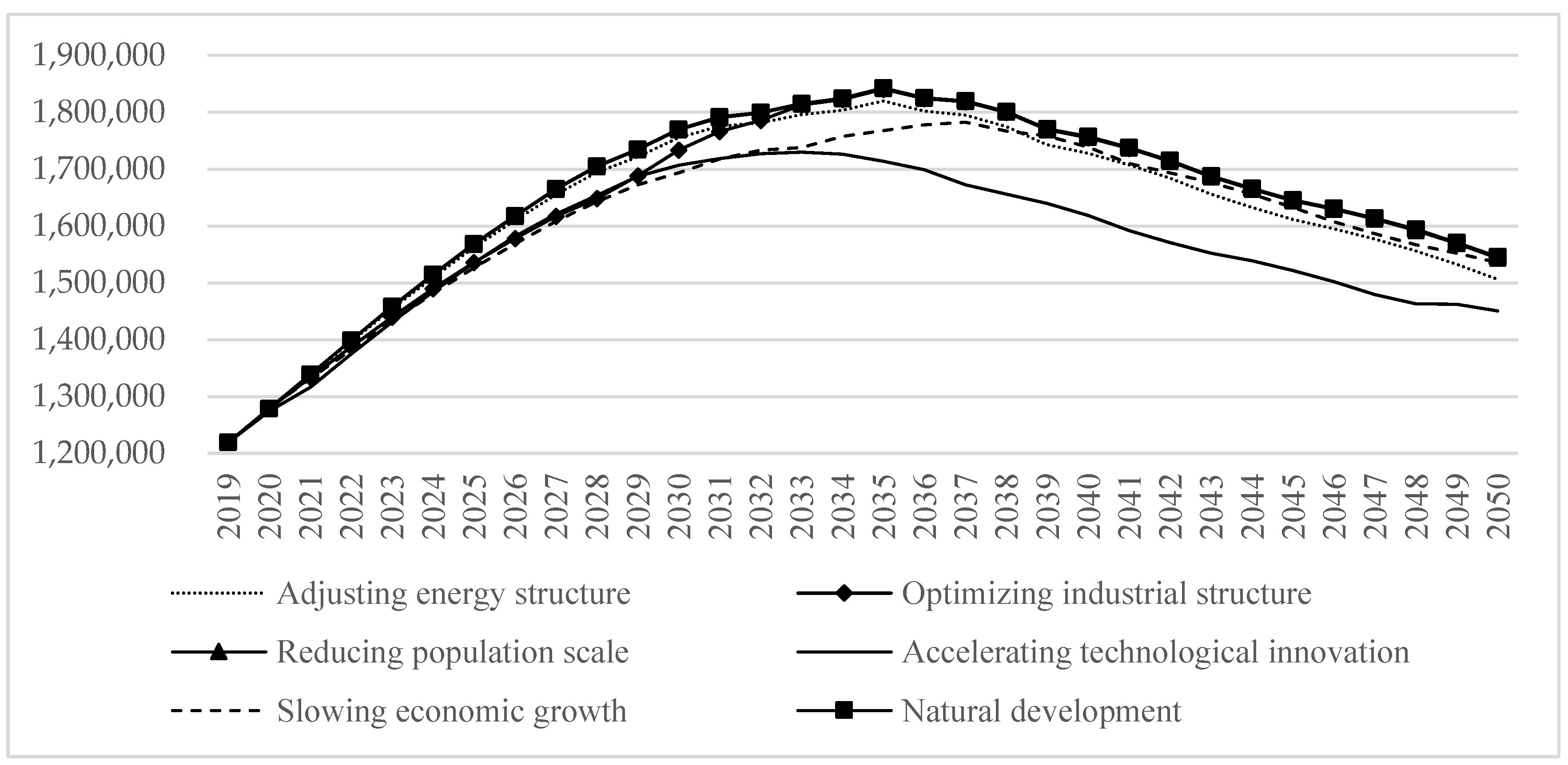Simulation of China’s Carbon Emission based on Influencing Factors
Abstract
:1. Introduction and Research Status
2. Research Model and Data Processing
2.1. Carbon Emission Calculation
2.2. System Dynamics Model
2.2.1. Causality Diagram
2.2.2. Stock-Flow Diagram
2.3. Formatting of Mathematical Components
2.4. Data Processing
3. Results and Discussion
3.1. China’s Carbon Emission Forecast Results
3.1.1. Validity Test
3.1.2. Parameter Setting
- (1)
- Setting population growth rate.
- (2)
- Setting GDP growth rate.
- (3)
- Setting industrial structure.
- (4)
- Setting energy consumption structure.
- (5)
- Setting the proportion of research and development expenditure.
3.1.3. Discussion on Peak Prediction Results
3.2. Analysis of China’s Carbon Emission Factors
- (1)
- Economic development factors have always shown a significant increasing effect on China’s carbon emissions. The impact of economic development on China’s carbon emissions rose from 132.223 million tons to 2948.27 million tons, an increase of 122.98%. The contribution rate of economic development is greater than that of other factors. From the perspective of development, China’s economy has developed rapidly since 1995. However, the rough and resource consumption-based economic development model relies heavily on energy consumption, so the factor of economic development is always promoting the growth of China’s carbon emissions. At present, China’s urbanization construction is not over; the living standards of residents need to be further improved, and economic development is still China’s first task. Therefore, while developing its economy rapidly, China should not only ensure quantity but also improve quality to achieve more economic growth with lower carbon emissions. China’s low-carbon development still has a long way to go.
- (2)
- Technological innovation factors have always shown a significant reducing effect on China’s carbon emissions. From 1995 to 2019, technological innovation factors reduced carbon emissions by 8964.59 million tons, and the contribution rate of carbon emission reduction exceeded 100%, far higher than those of other influencing factors. It is the best way to achieve China’s carbon emission reduction target. Since the beginning of the 21st century, China has formulated relatively strict ecological and environmental protection policies due to the challenges posed by high energy consumption to environmental and economic sustainable development. Improving energy efficiency has become key to reducing carbon emissions and energy dependence. In 2010, driven by China’s policies of accelerating the adjustment of heavy industry, reducing overcapacity and eliminating technologically backward industrial enterprises, China’s economic development gradually reduced its energy dependence, forming an economic development model with low pollution, low energy consumption and high output value. China’s energy intensity decreased from 2.43 in 1995 to 0.53 in 2019. In the future, China should learn from Japan, Germany and other technologically strong countries and implement more measures to reduce energy intensity.
- (3)
- The effect of industrial structure factors on China’s carbon emissions is mainly a reducing effect. The phase analysis shows the change trend from negative to positive and then to negative. From 1996 to 2001, China’s urbanization construction still needed to be improved. At this time, the industrial structure factor showed a weak downward effect. Since 2002, China has accelerated the construction of urbanization and focused on developing industries. In just six years, relying on its unique geographical location and population advantages, China has become a major country in the world’s economic development. To develop rapidly, many industrial enterprises do not carry out technological innovation and consume too much energy, resulting in the rapid growth of carbon emissions. However, after 2008, China gradually realized that consuming a lot of energy for economic development was not the best choice. China has formulated a series of industrial structure optimization policies to increase the proportion of the tertiary industry. Therefore, the contribution rate of industrial structure to carbon emission reduction has gradually increased.
- (4)
- The population-scale factor increases China’s carbon emissions; its influence degree is relatively stable, and its contribution rate is low. From 1995 to 2019, the population-scale factor increased carbon emissions by 968.13 million tons, with a contribution rate of 11.44%. The population scale has an increasing effect on carbon emissions, but it is relatively small. The impact of population scale on China’s carbon emissions will be limited in the future. First, the long-term implementation of the one-child policy has led to a gradual decline in China’s natural birth rate and slow population growth. The carbon emissions caused by the new population are gradually decreasing. Second, at this stage, residents pay attention to the improvement of quality of life and the construction of the spiritual world. Consumption tends to be in tertiary industries such as high-tech industries, and the increased effect on carbon emissions will continue to weaken.
- (5)
- Energy structure factors have a slight reducing effect on China’s carbon emissions.
- (6)
- There are two periods in which the energy structure cannot reduce China’s carbon emissions but shows a growth effect. This is mainly related to China’s energy reserves of “rich coal, poor oil and less gas”. From 2002 to 2007, China accelerated its economic and social construction and consumed a large amount of coal and oil, making China’s energy structure show a growth effect. After 2008, China accelerated upgrading its energy structure, with a substantial increase in gas consumption and a decline in the proportion of coal and oil consumption. China’s energy structure is developing towards low carbon. However, due to the impact of China’s energy resources, the energy structure shows only a slight reducing effect. In the future, China needs to continue to optimize its energy structure, increase the use of clean energy such as electricity, gas, wind energy and solar energy, and achieve China’s carbon emission reduction target.
3.3. Analysis of Carbon Emission Path in China
4. Conclusions
Author Contributions
Funding
Institutional Review Board Statement
Informed Consent Statement
Data Availability Statement
Acknowledgments
Conflicts of Interest
References
- Wu, L.; Zhu, Q. Impacts of the carbon emission trading system on China’s carbon emission peak: A new data-driven approach. Nat. Hazards 2021, 107, 2487–2515. [Google Scholar] [CrossRef]
- Tang, J.; Wang, Q.; Choi, G. Efficiency assessment of industrial solid waste generation and treatment processes with carry-over in China. Sci. Total Environ. 2020, 726, 138274. [Google Scholar] [CrossRef] [PubMed]
- Liu, J.; Li, S.; Ji, Q. Regional differences and driving factors analysis of carbon emission intensity from transport sector in China. Energy 2021, 224, 120178. [Google Scholar] [CrossRef]
- Li, B.; Han, S.; Wang, Y.; Wang, Y.; Li, J.; Wang, Y. Feasibility assessment of the carbon emissions peak in China construction industry: Factor de-composition and peak forecast. Sci. Total Environ. 2020, 706, 135716.1–135716.13. [Google Scholar] [CrossRef] [PubMed]
- Whitman, T.; Nicholson, C.F.; Torres, D.; Lehmann, J. Climate Change Impact of Biochar Cook Stoves in Western Kenyan Farm House-holds: System Dynamics Model Analysis. Environ. Sci. Technol. 2011, 45, 3687–3694. [Google Scholar] [CrossRef]
- He, C.; Okada, N.; Zhang, Q.; Shi, P.; Zhang, J. Modeling urban expansion scenarios by coupling cellular automata model and system dynamic model in Beijing, China. Appl. Geogr. 2006, 26, 323–345. [Google Scholar] [CrossRef]
- Tobias, M.I.; Cavana, R.Y.; Bloomfield, A. Application of a System Dynamics Model to Inform Investment in Smoking Cessation Services in New Zealand. Am. J. Public Health 2010, 100, 1274–1281. [Google Scholar] [CrossRef]
- Liu, D.; Xiao, B. Can China achieve its carbon emission peaking? A scenario analysis based on STIRPAT and system dynamics model. Ecol. Indic. 2018, 93, 647–657. [Google Scholar] [CrossRef]
- Feng, Y.Y.; Chen, S.Q.; Zhang, L.X. System dynamics modeling for urban energy consumption and CO2 emissions: A case study of Beijing, China. Ecol. Model. 2013, 252, 44–52. [Google Scholar] [CrossRef]
- Fong, W.K.; Matsumoto, H.; Lun, Y.F. Application of System Dynamics model as decision making tool in urban planning process toward stabilizing carbon dioxide emissions from cities. Build. Environ. 2009, 44, 1528–1537. [Google Scholar] [CrossRef]
- Mirzaei, M.; Bekri, M. Energy consumption and CO2 emissions in Iran, 2025. Environ. Res. 2017, 154, 345–351. [Google Scholar] [CrossRef] [PubMed]
- Lei, W.; Lu, B.; Zhang, E. System dynamic modeling and scenario simulation on Beijing industrial carbon emissions. Environ. Eng. Res. 2016, 21, 355–364. [Google Scholar]
- Kim, K.S.; Cho, Y.J.; Jeong, S.J. Simulation of CO2 emission reduction potential of the iron and steel industry using a system dy-namics model. Int. J. Precis. Eng. Manuf. 2014, 15, 361–373. [Google Scholar] [CrossRef]
- Lei, W.; Lu, B. System Dynamics Modeling and Policy Simulation for Urban Traffic: A Case Study in Beijing. Environ. Modeling Assess. 2017, 22, 363–378. [Google Scholar]
- Xie, Z.; Xuenong, G.; Wenhui, Y.; Jundong, F.; Zongbin, J. Decomposition and prediction of direct residential carbon emission indicators in Guangdong Province of China. Ecol. Indic. 2020, 115, 106344. [Google Scholar]
- Mao, G.; Dai, X.; Wang, Y.; Guo, J.; Cheng, X.; Fang, D.; Song, X.; He, Y.; Zhao, P. Reducing carbon emissions in China: Industrial structural upgrade based on system dynamics. Energy Strat. Rev. 2013, 2, 199–204. [Google Scholar] [CrossRef]
- Pan, X.; Li, M.; Xu, H.; Guo, S.; Guo, R.; Lee, C.T. Simulation on the effectiveness of carbon emission trading policy: A system dynamics approach. J. Oper. Res. Soc. 2020, 71, 1447–1460. [Google Scholar] [CrossRef]
- Dong, Y.; Xia, B.; Chen, W. Carbon footprint of urban areas: An analysis based on emission sources account model. Environ. Sci. Policy 2014, 44, 181–189. [Google Scholar] [CrossRef]
- Homer, J.B.; Hirsch, G.B. System Dynamics Modeling for Public Health: Background and Opportunities. Am. J. Public Health 2006, 96, 452–458. [Google Scholar] [CrossRef]
- Butts, M.; Drews, M.; Larsen, M.A.; Lerer, S.; Rasmussen, S.H.; Grooss, J.; Overgaard, J.; Refsgaard, J.C.; Christensen, O.B.; Christensen, J.H. Embedding complex hydrology in the regional climate system–Dynamic coupling across different modelling domains. Adv. Water Resour. 2014, 74, 166–184. [Google Scholar] [CrossRef]
- Guan, D.; Gao, W.; Su, W.; Li, H.; Hokao, K. Modeling and dynamic assessment of urban economy–resource–environment system with a coupled system dynamics–Geographic information system model. Ecol. Indic. 2011, 11, 1333–1344. [Google Scholar] [CrossRef]
- Forrester, J.W. System dynamics—The next fifty years. Syst. Dyn. Rev. 2010, 23, 359–370. [Google Scholar] [CrossRef]
- Ang, B.W. Decomposition analysis for policymaking in energy: Which is the preferred method? Energy Policy 2004, 32, 1131–1139. [Google Scholar] [CrossRef]
- Tang, D.; Zhang, Y.; Bethel, B.J. An Analysis of Disparities and Driving Factors of Carbon Emissions in the Yangtze River Economic Belt. Sustainability 2019, 11, 2362. [Google Scholar] [CrossRef] [Green Version]
- Yang, J.; Cai, W.; Ma, M.; Li, L.; Liu, C.; Ma, X.; Li, L.; Chen, X. Driving forces of China’s CO2 emissions from energy consumption based on Kaya-LMDI methods. Sci. Total Environ. 2019, 711, 134569. [Google Scholar] [CrossRef] [PubMed]
- Tang, D.; Ma, T.; Li, Z.; Tang, J.; Bethel, B.J. Trend Prediction and Decomposed Driving Factors of Carbon Emissions in Jiangsu Province during 2015–2020. Sustainability 2016, 8, 1018. [Google Scholar] [CrossRef] [Green Version]
- Jiang, J.; Ye, B.; Xie, D.; Tang, J. Provincial-level carbon emission drivers and emission reduction strategies in China: Combining multi-layer LMDI decomposition with hierarchical clustering. J. Clean. Prod. 2017, 169, 178–190. [Google Scholar] [CrossRef]
- Liu, L.; Wang, S.; Wang, K.; Zhang, R.; Tang, X. LMDI decomposition analysis of industry carbon emissions in Henan Province, China: Comparison between different 5-year plans. Nat. Hazards 2015, 80, 997–1014. [Google Scholar] [CrossRef]
- State Statistical Bureau. China Energy Statistical Yearbook 2020; China Statistic Press: Beijing, China, 2020. (In Chinese)
- State Statistical Bureau. China Statistical Yearbook 2020; China Statistic Press: Beijing, China, 2020. (In Chinese)
- He, C.; Shi, P.; Li, J. Scenarios simulation land use change in the northern China by system dynamic model. Acta Geogr. Sin. 2004, 59, 599–607. [Google Scholar]
- El-Gafy, I.K. System Dynamic Model for Crop Production, Water Footprint, and Virtual Water Nexus. Water Resour. Manag. 2014, 28, 4467–4490. [Google Scholar] [CrossRef]
- State Council of China. National Population Development Plan (2016–2030). 2016. Available online: http://www.gov.cn/zhengce/content/2017-01/25/content_5163309.htm (accessed on 26 April 2022).
- Tencent. The United Nations Predicts that China’s Future Population May Fall to Less than 1.4 Billion by 2050? But Is It Really the Case? 2022. Available online: https://xw.qq.com/amphtml/20220423A073C300 (accessed on 26 April 2022).
- Xinmin Evening News. Lin Yifu’s Outlook on the “Top of Shanghai”: China Can Achieve an Annual Growth of 5~6% by 2030. 2021. Available online: https://baijiahao.baidu.com/s?id=1697440100659195427&wfr=spider&for=pc (accessed on 26 April 2022).
- Yan, H. GDP Forecast of Major Countries in The World in 2050. 2018. Available online: https://www.bizchinalaw.com/archives/1926 (accessed on 26 April 2022).
- United Nations Development Program (UNDP). China and a Sustainable Future: Towards a Low Carbon Economy and Society; China Human Development Report; United Nations Development Program (UNDP): Geneva, Switzerland, 2009; pp. 47–73. [Google Scholar]
- Communist Party Member Network. The 14th Five Years Plan for National Economic and Social Development of The People’s Republic of China and The Outline of Long-Term Objectives for 2035. 2021. Available online: https://www.12371.cn/2021/03/13/ARTI1615598751923816.shtml (accessed on 26 April 2022).
- Global Network. PetroChina Released the 2020 Version of World and China Energy Outlook: China’s Path of Carbon Neutralization from the Perspective of Energy. 2020. Available online: https://baijiahao.baidu.com/s?id=1686314611374759683&wfr=spider&for=pc (accessed on 26 April 2022).
- Qilu Network. Wang Zhigang, Minister of Science and Technology: An Innovative Country Is a Very Important Part of the “Three Steps” of China as a Whole. 2019. Available online: https://baijiahao.baidu.com/s?id=1627674804257603313&wfr=spider&for=pc (accessed on 26 April 2022).
- State Statistical Bureau. China Statistical Yearbook on Science and Technology 2016; China Statistic Press: Beijing, China, 2020. (In Chinese)





| Year | GDP (100 Million Yuan) | Population (10,000 Persons) | Productive Energy Consumption (10,000 tce) | Living Energy Consumption (10,000 tce) | Carbon Emissions (10,000 Tons) | ||||||||||
|---|---|---|---|---|---|---|---|---|---|---|---|---|---|---|---|
| Simulation Value | Actual Value | Error (%) | Simulation Value | Actual Value | Error (%) | Simulation Value | Actual Value | Error (%) | Simulation Value | Actual Value | Error (%) | Simulation Value | Actual Value | Error (%) | |
| 1995 | 61,340 | 61,340 | 0.00% | 121,121 | 121,121 | 0.00% | 138,557 | 138,550 | 0.00% | 10,235 | 10,240 | −0.05% | 370,520 | 372,795 | −0.61% |
| 1996 | 71,811 | 71,814 | 0.00% | 122,393 | 122,389 | 0.00% | 146,225 | 146,082 | 0.10% | 8215 | 8111 | 1.28% | 383,007 | 385,815 | −0.73% |
| 1997 | 79,710 | 79,715 | −0.01% | 123,629 | 123,626 | 0.00% | 148,267 | 147,166 | 0.75% | 7797 | 7727 | 0.91% | 380,028 | 385,331 | −1.38% |
| 1998 | 85,194 | 85,196 | 0.00% | 124,766 | 124,761 | 0.00% | 147,376 | 146,378 | 0.68% | 7598 | 7550 | 0.64% | 377,609 | 382,553 | −1.29% |
| 1999 | 90,561 | 90,564 | 0.00% | 125,789 | 125,786 | 0.00% | 152,193 | 153,196 | −0.65% | 7484 | 7381 | 1.39% | 391,353 | 397,474 | −1.54% |
| 2000 | 100,278 | 100,280 | 0.00% | 126,745 | 126,743 | 0.00% | 157,255 | 159,242 | −1.25% | 7163 | 7267 | −1.44% | 402,688 | 410,012 | −1.79% |
| 2001 | 110,858 | 110,863 | 0.00% | 127,633 | 127,627 | 0.00% | 164,805 | 163,772 | 0.63% | 7215 | 7410 | −2.62% | 411,717 | 421,405 | −2.30% |
| 2002 | 121,711 | 121,717 | −0.01% | 128,462 | 128,453 | 0.01% | 173,637 | 172,635 | 0.58% | 7401 | 7456 | −0.74% | 436,171 | 443,168 | −1.58% |
| 2003 | 137,411 | 137,422 | −0.01% | 129,233 | 129,227 | 0.00% | 207,102 | 201,121 | 2.97% | 8090 | 8085 | 0.07% | 510,115 | 517,040 | −1.34% |
| 2004 | 161,829 | 161,840 | −0.01% | 129,995 | 129,988 | 0.01% | 234,248 | 232,271 | 0.85% | 9252 | 9152 | 1.09% | 581,318 | 596,534 | −2.55% |
| 2005 | 187,301 | 187,319 | −0.01% | 130,762 | 130,756 | 0.00% | 257,798 | 259,811 | −0.77% | 9624 | 9623 | 0.01% | 663,737 | 669,146 | −0.81% |
| 2006 | 219,424 | 219,438 | −0.01% | 131,456 | 131,448 | 0.01% | 286,885 | 284,899 | 0.70% | 10,322 | 10,127 | 1.93% | 728,545 | 732,307 | −0.51% |
| 2007 | 270,067 | 270,092 | −0.01% | 132,139 | 132,129 | 0.01% | 309,652 | 303,676 | 1.97% | 10,656 | 10,761 | −0.97% | 777,279 | 777,806 | −0.07% |
| 2008 | 319,219 | 319,245 | −0.01% | 132,813 | 132,802 | 0.01% | 311,896 | 314,903 | −0.95% | 10,798 | 10,803 | −0.05% | 804,170 | 802,703 | 0.18% |
| 2009 | 348,491 | 348,518 | −0.01% | 133,464 | 133,450 | 0.01% | 356,600 | 356,633 | −0.01% | 11,471 | 11,172 | 2.67% | 917,269 | 912,028 | 0.57% |
| 2010 | 412,091 | 412,119 | −0.01% | 134,104 | 134,091 | 0.01% | 389,607 | 388,602 | 0.26% | 12,384 | 12,278 | 0.86% | 995,092 | 988,848 | 0.63% |
| 2011 | 487,915 | 487,940 | −0.01% | 134,748 | 134,735 | 0.01% | 423,328 | 426,339 | −0.71% | 13,413 | 13,315 | 0.74% | 1,097,110 | 1,082,866 | 1.32% |
| 2012 | 538,561 | 538,580 | 0.00% | 135,422 | 135,404 | 0.01% | 443,305 | 453,319 | −2.21% | 14,143 | 14,041 | 0.73% | 1,175,340 | 1,148,774 | 2.31% |
| 2013 | 592,955 | 592,963 | 0.00% | 136,085 | 136,072 | 0.01% | 471,667 | 470,668 | 0.21% | 14,761 | 14,857 | −0.65% | 1,208,170 | 1,187,880 | 1.71% |
| 2014 | 643,535 | 643,563 | 0.00% | 136,793 | 136,782 | 0.01% | 473,065 | 471,051 | 0.43% | 15,530 | 15,435 | 0.62% | 1,202,810 | 1,182,615 | 1.71% |
| 2015 | 688,839 | 688,858 | 0.00% | 137,477 | 137,462 | 0.01% | 465,147 | 466,153 | −0.22% | 16,380 | 16,578 | −1.19% | 1,222,250 | 1,165,298 | 4.89% |
| 2016 | 746,357 | 746,395 | −0.01% | 138,288 | 138,271 | 0.01% | 467,793 | 464,788 | 0.65% | 16,740 | 16,935 | −1.15% | 1,163,930 | 1,156,430 | 0.65% |
| 2017 | 831,965 | 832,036 | −0.01% | 139,021 | 139,008 | 0.01% | 478,115 | 473,112 | 1.06% | 17,403 | 17,506 | −0.59% | 1,190,600 | 1,167,363 | 1.99% |
| 2018 | 919,238 | 919,281 | 0.00% | 139,549 | 139,538 | 0.01% | 478,192 | 488,201 | −2.05% | 17,160 | 17,356 | −1.13% | 1,222,650 | 1,191,096 | 2.65% |
| 2019 | 986,434 | 986,515 | −0.01% | 140,010 | 140,005 | 0.00% | 501,371 | 502,400 | −0.20% | 17,247 | 17,342 | −0.55% | 1,254,060 | 1,219,177 | 2.86% |
| Year | Energy Structure | Technological Innovation | Industrial Structure | Economic Development | Population Scale | Total |
|---|---|---|---|---|---|---|
| 1995 | 0 | 0 | 0 | 0 | 0 | 0 |
| 1996–1998 | −4478 | −129,973 | −1869 | 132,223 | 13,855 | 9758 |
| 1999–2001 | −3239 | −59,262 | −2422 | 94,979 | 8795 | 38,852 |
| 2002–2004 | 2398 | −22,835 | 10,650 | 176,245 | 8670 | 175,129 |
| 2005–2007 | 2139 | −176,385 | 6503 | 337,990 | 11,024 | 181,272 |
| 2008–2010 | −1200 | −114,914 | −28,027 | 342,858 | 12,325 | 211,042 |
| 2011–2013 | −5010 | −116,228 | −69,744 | 373,990 | 16,025 | 199,032 |
| 2014–2016 | −12,430 | −98,843 | −94,741 | 162,285 | 12,280 | −31,450 |
| 2017–2019 | −22,834 | −178,020 | −45,067 | 294,827 | 13,840 | 62,747 |
| 1996–2019 | −44,653 | −896,459 | −224,715 | 1915,396 | 96,813 | 846,382 |
| Paths | Peak Year (Year) | Peak Value (10,000 Tons) | Accumulative Carbon Emissions (10,000 Tons) | Carbon Emission Intensity (10,000 Tons/100 Million Yuan) | ||
|---|---|---|---|---|---|---|
| 2020 | 2030 | 2050 | ||||
| Natural development | 2035 | 1,842,720 | 52,726,057 | 1.26 | 0.91 | 0.39 |
| Slowing economic growth | 2037 | 1,782,340 | 51,585,297 | 1.26 | 0.93 | 0.44 |
| Accelerating technological innovation | 2033 | 1,729,740 | 49,914,457 | 1.25 | 0.88 | 0.36 |
| Optimizing industrial structure | 2035 | 1,840,600 | 52,334,597 | 1.26 | 0.89 | 0.39 |
| reducing population scale | 2035 | 1,841,550 | 52,691,877 | 1.26 | 0.91 | 0.39 |
| Adjusting energy structure | 2035 | 1,819,850 | 52,066,167 | 1.26 | 0.9 | 0.38 |
Publisher’s Note: MDPI stays neutral with regard to jurisdictional claims in published maps and institutional affiliations. |
© 2022 by the authors. Licensee MDPI, Basel, Switzerland. This article is an open access article distributed under the terms and conditions of the Creative Commons Attribution (CC BY) license (https://creativecommons.org/licenses/by/4.0/).
Share and Cite
Kong, H.; Shi, L.; Da, D.; Li, Z.; Tang, D.; Xing, W. Simulation of China’s Carbon Emission based on Influencing Factors. Energies 2022, 15, 3272. https://doi.org/10.3390/en15093272
Kong H, Shi L, Da D, Li Z, Tang D, Xing W. Simulation of China’s Carbon Emission based on Influencing Factors. Energies. 2022; 15(9):3272. https://doi.org/10.3390/en15093272
Chicago/Turabian StyleKong, Haojia, Lifan Shi, Dan Da, Zhijiang Li, Decai Tang, and Wei Xing. 2022. "Simulation of China’s Carbon Emission based on Influencing Factors" Energies 15, no. 9: 3272. https://doi.org/10.3390/en15093272
APA StyleKong, H., Shi, L., Da, D., Li, Z., Tang, D., & Xing, W. (2022). Simulation of China’s Carbon Emission based on Influencing Factors. Energies, 15(9), 3272. https://doi.org/10.3390/en15093272








